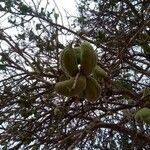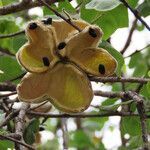A dumpy tree. The trunk is swollen. It is often 3 m high but can be 8 m high. It usually branches near the base. The trunk is stout and shiny. The main branches are robust and grey. The leaves are alternate. They are on long wand like branches clustered at the ends. They are 2.5-6 cm long and often with 3-5 lobes. The lobes have a sharp point. They leaves are dark green above and greyish-green below. The flowers are separately male and female on the same tree. They are yellow-green streaked with red and 1.5 cm across. The fruit consists of 1-5 stalkless lobes or separate parts.
Leaves borne singly or clustered on the ends of short side-shoots; lamina up to 6 × 5 cm., very broadly cordate-ovate, entire or very shallowly and sinuately 3–5-lobed, apex obtuse or subacute, minutely puberulous above, whitish and tomentellous below, 5–7-nerved at the base; petiole up to 2 cm. long, tomentellous.
Small tree, up to 6 m high. Leaves simple, lamina broadly ovate, shallowly and sinuately 3-5-lobed, base cordate. Fruit of 5 free follicles, outer surface densely stellate hairy. Flowers greenish yellow flushed with pink, marked with pink or red.
Follicles 3–5, up to 7–5 cm. long, oblong-ovoid, spreading, subsessile, apical horn up to 1·3 mm. long, golden-tomentellous outside, pale and tomentellous inside; placentas with very dense acicular hairs.
Flowers in clusters on the short side-shoots, appearing before the leaves; pedicels up to 5 mm. long, tomentellous, articulated near the middle; bracteoles c. 1–5 mm. long, linear, pubescent, caducous.
Small tree up to 5 m. tall with rather slender branches and often branching low down; bark brown and peeling in papery flakes.
Flowers yellowish-green with reddish guide-lines within, very similar in size and structure to those of S. africana.
Seeds numerous, like those of S.africana but only 1–1·3 × 0·7 cm,



